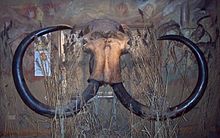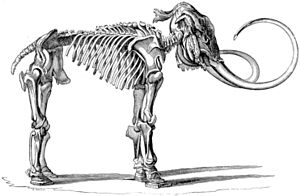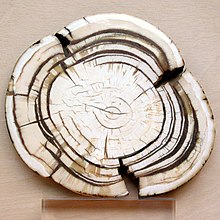真猛犸象
| 真猛犸象 | |
|---|---|

| |
绝灭(公元前1700年/化石)
| |
| 科学分类 | |
| 界: | 动物界 Animalia |
| 门: | 脊索动物门 Chordata |
| 纲: | 哺乳纲 Mammalia |
| 目: | 长鼻目 Proboscidea |
| 科: | 象科 Elephantidae |
| 属: | †猛犸象属 Mammuthus |
| 种: | †真猛犸象 M. primigenius
|
| 二名法 | |
| †Mammuthus primigenius (Blumenbach, 1799)
| |

| |
| 末次冰期真猛犸的分布范围 | |
| 异名 | |
| |
真猛犸象(英语:woolly mammoth,学名:Mammuthus primigenius)是已灭绝的猛犸象。在北美洲及欧亚大陆北部发现有牠们的骨头及冷藏的尸体,而保存最完好的是在西伯利亚。已知最古老(15万年前)的真猛犸象是在欧亚大陆的利斯冰期矿床被发现。牠们是自草原猛犸象衍生而来[1]。真猛犸象于更新世晚期从大部分分布地消失,在弗兰格尔岛上仍存有一族较小的的真猛犸象至约公元前1700年[2]。
特征
[编辑]
真猛犸象有大量的化石纪录,但却没有被石化,而是自其死亡时就已保存下来。原因可能是其巨大的体型及寒冷气候。故科学家可以对真猛犸象的解剖有详细的了解[3]。
真猛犸象可以分为两类(或亚种)。一类生活在北极的高地,另一类则分布较广[4]。真猛犸象虽然很大,但并非如想像般巨型。事实上,牠们并不比现今亚洲象大很多。成年的雄性真猛犸象高2.8-4.0米,而侏儒化的则有1.8-2.3米高。牠们可以重达8吨。
真猛犸象长有厚厚的毛,毛长达1米,且有内层绒毛,可以抵御严寒。毛皮像麝牛,于夏天可能会脱皮。牠们的耳朵较现今的象小很多,最大的也只有30厘米长。牠们的头部很高而且尖,在很多石洞壁画中都描绘成节状。由于脊骨很长,肩膀上隆起像驼背,可能藏有大量的脂肪。象鼻端的上唇是一块阔叶,而下唇则像阔及方的盖。
真猛犸象的牙齿适合吃冻土层粗糙的草,有着较多的托基及较高的牙冠。牠们的皮肤与现今象的差不多一样厚,但有大量的皮脂腺可以分泌油脂到毛发上,加强保温效果。牠们的皮下脂肪层厚达8厘米,功能就像鲸鱼的鲸脂一样。
真猛犸象的象牙长达5米,比普通象牙更为弯曲。象牙的形状及长度是否其适应性并不清楚,但有指牠们可能利用象牙来清除地上的积雪寻找食物。另外,很多标本的象牙面上都有磨损,可能是有很多动物寄住在其象牙上。
灭绝
[编辑]一般假设真猛犸象是于1万年前在欧洲及西伯利亚南部消失,但新资料显示牠们仍存活至8千年前。稍后一些时间,牠们也从西伯利亚北部消失[5]。牠们与哥伦比亚猛犸及其他更新世巨型动物群于末次冰期一同在北美洲消失。只有少数仍在圣保罗岛生存至前3750年[6][7][8],也有在弗兰格尔岛上的生存至前1700年,牠们的体型较小,但没有达到岛屿侏儒化的程度[9][10]。
大部分真猛犸象于更新世晚期死亡,可能是因气候转变及/或被人类猎杀。有研究指出温暖的气候是令牠们受到威胁的元凶,令牠们的数量在人类出现前大幅减少[11]。冰川消退令牠们的栖息地由4.2万年前的770万平方公里减少至6千年前的80万平方公里。虽然于12.5万年前的萨勒冰期末也有类似的情况,但人类压力却使得他们牠们走向灭绝[12]。不过也有研究认为较长命的群落是生存在岛屿上的,而其栖息地也有限,故栖息地未必一定是其灭绝的主要成因。事实上,一些居住在美洲温带或热带的长鼻目也于更新世末灭绝(第四纪灭绝事件)[13][14]。
发现历史
[编辑]
西伯利亚原住民早已发现真猛犸象的遗骸,并拿象牙来贸易。他们相信这些遗骸是来自巨型的鼹科动物,而这些动物是生活在地底并走到地面时死亡[15]。于1600年代,在欧洲有时也有发现真猛犸象的报告。他们一般会按《圣经》来解释,认为是巨兽或巨人的遗骸[3]。“猛犸”一字源自俄语мамант一词(今写作“мамонт”)[16],其词源可能来自一种乌拉尔语,表示*mē̮ŋ“土地”及*ońt“角”,比较汉特语ма̄(“土地”)、а̄ньт(“角”)。
真猛犸象遗骸最早的科学鉴别是由英国科学家汉斯·斯隆(Hans Sloane)于1728年进行。这套遗骸包括了在西伯利亚发现的化石化牙齿弓及象牙。斯隆指这些遗骸并不属于“比蒙”或巨人,而是属于象的。他认为在传说的大洪水前西伯利亚是热带气候的,但大洪水大幅改变了当地的气候,并埋葬了这套象的遗骸。其他的则指可能是大洪水将象由热带冲到北极[3]。
法国科学家乔治·居维叶(Georges Cuvier)于1796年指真猛犸象并不是现今的象被带到北极,而是一个全新的物种。他指牠们已经完全灭绝[17]。约翰·弗里德里希·布卢门巴赫(Johann Friedrich Blumenbach)之后替真猛犸象起了其学名为Elephas primigenius,并分类在象属中。直至1828年,乔舒亚·布鲁克斯(Joshua Brookes)则认为牠们应该有独立的属,并将之重新分类在猛犸象属中[3]。
与此同时,真猛犸象首次于北美洲被发掘出来。马克·盖茨比(Mark Catesby)于1743年在北卡罗莱纳州发现几只大型牙齿,其非洲奴隶确认为象的臼齿。于1806年,威廉·克拉克(William Clark)在美国总统托马斯·杰斐逊指示下,在肯塔基州发现了几个真猛犸象的标本[3]。
冷藏遗骸
[编辑]
于1799年,一名猎人在勒拿河河岸发掘出一套真猛犸象的标本。他为了要得到其象牙作买卖,由得这个标本融化,并在得到象牙后弃掉了这个标本。这个标本大幅腐化,甚至可能被狼所掠食[3][18]。于1806年,植物学家米哈伊尔·亚当斯(Mikhail Adams)跟随尤里·亚历山德罗夫·戈洛夫金的使团来到西伯利亚,寻回了这个标本,并将之带回了圣彼得堡进行研究,是为亚当长毛象(Adams mammoth)[3]。
在西伯利亚北部续有发现冷藏的真猛犸象遗骸。要冷藏起遗骸是很复杂的事情,必须以液体或半固体(如淤泥或冰水)急速将动物埋葬及结冰。真猛犸象可能被困在沼泽或流沙中死亡。从一些标本的胃部内仍有一些未被消化的食物或口内仍含有种子可见,牠们并非死于饥饿。从吞下的植物成熟度推断,牠们应该是在秋天时份死亡[19]。牠们也有可能是掉下了冰永的湖内溺毙。当中有很多肯定是在河流中死亡,有可能是被河水泛滥冲走。在雅库特的白列雷克河附近,在单一位点内就发现了超过9000块骨头,最少有156个个体,很有可能是被水流所冲走[20]。

于1977年,在西伯利亚东北部科雷马河支流上的永久冻土发掘出一只只有7-8个月大的幼生真猛犸象,名为“帝玛”。帝玛死亡时约重100公斤,高1.04米,长1.15米。放射性碳定年法确定帝玛约于4万年前死亡,其内脏像现今的象,耳朵却只有同龄非洲象的十分之一[1]。
于1997年8月,在西伯利亚泰梅尔半岛发现了一只从冻土层伸出的真猛犸象的象牙。同年9月/10月间,这个20380岁的尸体,连同周边重25吨的泥土由超重直升机运送到泰梅尔(多尔干-涅涅茨)自治区哈坦加的冰洞内。于2000年10月,研究人员小心翼翼地进行融冰过程,保存了标本的毛发及其他软组织[21][22]。
于2007年5月,在近尤瑞贝河的冻土层发现一只1个月大的雌性真猛犸象,起名为“柳芭”,估计被埋葬了42000年。其DNA相信被完好保存下来,可以作为猛犸象的种系发生学及生理学进行研究[23][24]。至今共发现了39个保存下来的真猛犸象躯体,但只有4个是完整的。大部分标本的肉体在冷藏前就已有腐化的痕迹[25]。
除了被冷藏的尸体外,在西伯利亚也发现了大量的真猛犸象象牙。牠们的象牙最少已被贸易了2000年,至今仍是极贵重的货品。相传13世纪的蒙古大汗贵由的玉座就是以真猛犸象的象牙所做成[26]。
遗传学
[编辑]
由于亚洲象及非洲象成功诞下了一只混种,有指若真猛犸象仍然在生,牠们也可以与印度象混种。这种想法衍生了若从冷藏的真猛犸象中抽取其基因,再与现今的印度象结合,就可以生出像真猛犸象的野兽。科学家希望从冷藏的真猛犸象生殖器中抽取及活化其精子,但不成功。另一个想法是将之复制,日本的研究队就已经成功从已冷藏了16年的老鼠脑部中抽取出DNA,希望可以套用在真猛犸象身上[27]。
虽然现在仍未能抽取可用的DNA,真猛犸象的线粒体基因组已完全被确定[28]。从而发现猛犸象、非洲象及亚洲象在很短的时间内分支,而猛犸象较为接近亚州象。非洲象约于600万年前从真猛犸象分支开来。研究发现真猛犸象的毛发颜色是由黑色素皮质素受体1所决定。[29]另外于2008年,真猛犸象的大部分DNA已经被图谱出来,且发现有两类真猛犸象,其一于4.5万年前灭绝,另一类则于1万年前消失。而研究也发现牠们与非洲象的DNA相似度达98.55%[30]至99.4%[31]。
神秘生物学
[编辑]有指真猛犸象并非完全灭绝,在北半球较偏远的冻土层仍可能存有少量的群落。于19世纪末,不断有指牠们仍在阿拉斯加生存[32]。于1899年,有人声称在阿拉斯加杀死了一头真猛犸象且将尸体捐给了史密森尼学会,但遭到史密森尼学会否认[33]。另外,也谣传在俄罗斯出现了大型及长满毛的野兽[32]。
参考
[编辑]- ^ 1.0 1.1 Yukon Beringia Interpretive Centre - Woolly Mammoth. www.beringia.com. 1995 [2009-03-26]. (原始内容存档于2009-04-03).
- ^ Nowak, Ronald M. Walker's Mammals of the World. Baltimore: Johns Hopkins University Press. 1999. ISBN 0801857899.
- ^ 3.0 3.1 3.2 3.3 3.4 3.5 3.6 The Academy of Natural Sciences. Woolly Mammoth (Mammuthus primigenius). The Academy of Natural Sciences. 2007 [September 29, 2007]. (原始内容存档于2007-09-27).
- ^ Gilbert, M. Thomas P.; Drautz, Daniela I.; Lesk, Arthur M.; Ho, Simon Y. W.; Qi, Ji; Ratan, Aakrosh; Hsu, Chih-Hao; Sher, Andrei; Dalén, Love. Intraspecific phylogenetic analysis of Siberian woolly mammoths using complete mitochondrial genomes. Proceedings of the National Academy of Sciences. 2008-06-17, 105 (24): 8327–8332 [2022-02-27]. ISSN 0027-8424. PMC 2423413
 . PMID 18541911. doi:10.1073/pnas.0802315105. (原始内容存档于2022-02-27) (英语).
. PMID 18541911. doi:10.1073/pnas.0802315105. (原始内容存档于2022-02-27) (英语).
- ^ Stuart, Anthony J.; Sulerzhitsky, Leopold D.; Orlova, Lyobov A.; Kuzmin, Yaroslav V.; Lister, Adrian M. The latest woolly mammoths (Mammuthus primigenius Blumenbach) in Europe and Asia: a review of the current evidence. Quaternary Science Reviews. 2002-08, 21 (14-15): 1559–1569 [2022-02-27]. doi:10.1016/S0277-3791(02)00026-4. (原始内容存档于2022-06-17) (英语).
- ^ David R. Yesner, Douglas W. Veltre, Kristine J. Crossen, and Russell W. Graham, “5,700-year-old Mammoth Remains from Qagnax Cave, Pribilof Islands, Alaska”, Second World of Elephants Congress, (Hot Springs: Mammoth Site, 2005), 200-203.
- ^ Kristine J. Crossen. 5,700-Year-Old Mammoth Remains from the Pribilof Islands, Alaska: Last Outpost of North America Megafauna. Geological Society of America Abstracts with Programs. 2005, 37 (7): 463.
- ^ Dale Guthrie, R. Radiocarbon evidence of mid-Holocene mammoths stranded on an Alaskan Bering Sea island. Nature. 2004-06, 429 (6993): 746–749 [2022-02-27]. ISSN 0028-0836. doi:10.1038/nature02612. (原始内容存档于2022-06-21) (英语).
- ^ Vartanyan, S. L.; Garutt, V. E.; Sher, A. V. Holocene dwarf mammoths from Wrangel Island in the Siberian Arctic. Nature. 1993-03, 362 (6418): 337–340 [2022-02-27]. ISSN 0028-0836. doi:10.1038/362337a0. (原始内容存档于2022-06-21) (英语).
- ^ Vartanyan, Sergey L.; Arslanov, Khikmat A.; Karhu, Juha A.; Possnert, Göran; Sulerzhitsky, Leopold D. Collection of radiocarbon dates on the mammoths ( Mammuthus Primigenius ) and other genera of Wrangel Island, northeast Siberia, Russia. Quaternary Research. 2008-07, 70 (1): 51–59. Bibcode:2008QuRes..70...51V. ISSN 0033-5894. doi:10.1016/j.yqres.2008.03.005 (英语).
- ^ Nogués-Bravo, David; Rodríguez, Jesús; Hortal, Joaquín; Batra, Persaram; Araújo, Miguel B. Barnosky, Anthony , 编. Climate Change, Humans, and the Extinction of the Woolly Mammoth. PLoS Biology. 2008-04-01, 6 (4): e79. ISSN 1545-7885. PMC 2276529
 . PMID 18384234. doi:10.1371/journal.pbio.0060079 (英语).
. PMID 18384234. doi:10.1371/journal.pbio.0060079 (英语).
- ^ Sedwick, Caitlin. What Killed the Woolly Mammoth?. PLoS Biology. 2008-04-01, 6 (4): e99. ISSN 1545-7885. PMC 2276526
 . PMID 20076709. doi:10.1371/journal.pbio.0060099 (英语).
. PMID 20076709. doi:10.1371/journal.pbio.0060099 (英语).
- ^ Martin, Paul Schultz. Twilight of the Mammoths: Ice Age Extinctions and the Rewilding of America. University of California Press. 2005 [2022-02-27]. ISBN 978-0-520-23141-2. (原始内容存档于2022-02-27) (英语).
- ^ Burney, D; Flannery, T. Fifty millennia of catastrophic extinctions after human contact. Trends in Ecology & Evolution. 2005-07, 20 (7): 395–401 [2022-02-27]. doi:10.1016/j.tree.2005.04.022. (原始内容存档于2022-02-04) (英语).
- ^ Breyne, J.P. Observations, and a Description of Some Mammoth's Bones Dug Up in Siberia, Proving Them to Have Belonged to Elephants. Philosophical Transactions. 1741, 40 (1737-1378): 124–39.
- ^ Simpson, J. Word Stories: Mammoth. Oxford English Dictionary Online. Oxford University Press. 2009 [2009-06-05]. (原始内容存档于2010-04-19).
- ^ Cuvier, G. Mémoire sur les épèces d'elephans tant vivantes que fossils, lu à la séance publique de l'Institut National le 15 germinal, an IV. Magasin encyclopédique, 2e anée. 1796, 3: 440–5 (法语).
- ^ Granqvist, Eirik. Mammouth - from their discovery and how to bring them the life. Paper from the NATHIST annual meeting in Jakobstad. 2005 [2009-09-22]. (原始内容存档于2019-05-29).
- ^ Pfizenmayer, E. W. Siberian Man and Mammoth. London: Blackie and Son. 1939.
- ^ Harington, C.R. Woolly mammoth. Beringian Research Notes (Yukon Tourism). 1995, 2: 4.
- ^ Mol, D.; et al. The Jarkov Mammoth: 20,000-Year-Old carcass of a Siberian woolly mammoth Mammuthus primigenius (Blumenbach, 1799) (PDF). The World of Elephants, Proceedings of the 1st International Congress (October 16-20 2001, Rome). 2001: 305–9. (原始内容 (PDF)存档于2006-04-27).
- ^ Debruyne, Régis; Barriel, Véronique; Tassy, Pascal. Mitochondrial cytochrome b of the Lyakhov mammoth (Proboscidea, Mammalia): new data and phylogenetic analyses of Elephantidae. Molecular Phylogenetics and Evolution. 2003-03, 26 (3): 421–434 [2022-02-27]. doi:10.1016/S1055-7903(02)00292-0. (原始内容存档于2022-06-18) (英语).
- ^ Baby mammoth discovery unveiled. 2007-07-10 [2022-02-27]. (原始内容存档于2017-08-20) (英国英语).
- ^ Solovyov, Dmitry. Baby mammoth find promises breakthrough. reuters.com (Reuters). 2007-07-11 [2007-07-13]. (原始内容存档于2018-12-26).
- ^ Farrand, William R. Frozen Mammoths and Modern Geology: The death of the giants can be explained as a hazard of tundra life, without evoking catastrophic events.. Science. 1961-03-17, 133 (3455): 729–735 [2022-02-27]. ISSN 0036-8075. doi:10.1126/science.133.3455.729. (原始内容存档于2022-03-16) (英语).
- ^ Tolmachoff, I. P. The Carcasses of the Mammoth and Rhinoceros Found in the Frozen Ground of Siberia. Transactions of the American Philosophical Society. 1929, 23 (1): i [2022-02-27]. doi:10.2307/1005437. (原始内容存档于2022-05-04).
- ^ Cloned Mammoths Made More Likely by Frozen Mice. FOXNews.com. [2008-11-04]. (原始内容存档于2008-12-07).
- ^ Krause, Johannes; Dear, Paul H.; Pollack, Joshua L.; Slatkin, Montgomery; Spriggs, Helen; Barnes, Ian; Lister, Adrian M.; Ebersberger, Ingo; Pääbo, Svante. Multiplex amplification of the mammoth mitochondrial genome and the evolution of Elephantidae. Nature. 2006-02, 439 (7077): 724–727 [2022-02-27]. ISSN 0028-0836. doi:10.1038/nature04432. (原始内容存档于2022-06-23) (英语).
- ^ Römpler, Holger; Rohland, Nadin; Lalueza-Fox, Carles; Willerslev, Eske; Kuznetsova, Tatyana; Rabeder, Gernot; Bertranpetit, Jaume; Schöneberg, Torsten; Hofreiter, Michael. Nuclear Gene Indicates Coat-Color Polymorphism in Mammoths. Science. 2006-07-07, 313 (5783): 62–62 [2022-02-27]. ISSN 0036-8075. doi:10.1126/science.1128994. (原始内容存档于2022-06-11) (英语).
- ^ Poinar, Hendrik N.; Schwarz, Carsten; Qi, Ji; Shapiro, Beth; MacPhee, Ross D. E.; Buigues, Bernard; Tikhonov, Alexei; Huson, Daniel H.; Tomsho, Lynn P. Metagenomics to Paleogenomics: Large-Scale Sequencing of Mammoth DNA. Science. 2006-01-20 [2022-02-27]. doi:10.1126/science.1123360. (原始内容存档于2022-02-27) (英语).
- ^ Will findings recreate the woolly mammoth?. Pittsburgh Post-Gazette. 2008-11-20 [2009-09-22]. (原始内容存档于2009-02-11).
- ^ 32.0 32.1 Sjögren, Bengt. Farliga djur och djur som inte finns, Prisma, 1962
- ^ Murray, Morgan. Henry Tukeman: Mammoth's Roar was Heard All The Way to the Smithsonian. www2.tpl.lib.wa.us. [2008-01-17]. (原始内容存档于2008-02-20).
外部链接
[编辑]- Has anybody ever eaten the meat of a frozen mammoth?
- Mammoth Genome Cracked: Key to Cloning? in Cosmos Online (页面存档备份,存于互联网档案馆)
| ||||||||||||
Text is available under the CC BY-SA 4.0 license; additional terms may apply.
Images, videos and audio are available under their respective licenses.
